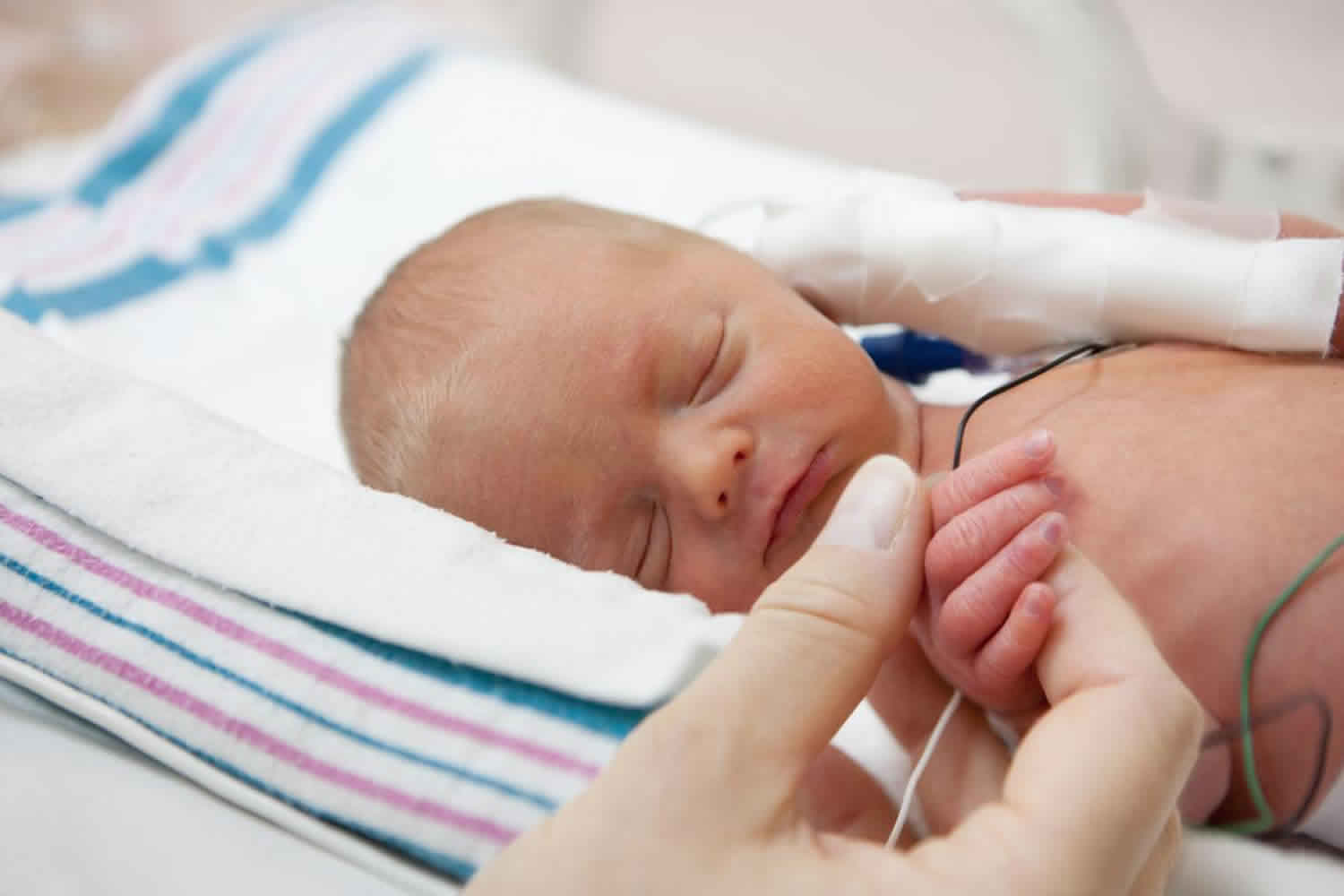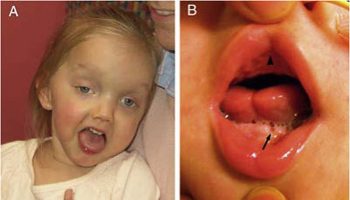Low birthweight
Low birthweight is when a baby is born weighing less than 2500 grams (less than 5 pounds, 8 ounces). In contrast, the average newborn weighs about 8 pounds (3628 grams). Some babies with low birthweight are healthy, even though they’re small. But being low birthweight can cause serious health problems for some babies. A baby with low birthweight may have trouble eating, gaining weight and fighting off infections. Some low-birthweight babies may have long-term health problems too, with an increased risk of physical and mental disabilities. This risk becomes significant for those babies born weighing less than 1500 g. About 1 in 12 babies (about 8 percent) in the United States is born with low birthweight. The overall rate of these very small babies in the United States is increasing. This is primarily due to the greater numbers of multiple birth babies who are more likely to be born early and weigh less. Over half of multiple birth babies have low birthweight compared with only about 6 percent of single birth babies.
Low birth weight infants can be further classified into ‘very low birth weight’ (VLBW) if they weigh 1000–1500 g and ‘extremely low birth weight’ (ELBW) if they weigh less than 1000 g. Such low birth weights are seen in infants who are born extremely prematurely.
The primary cause of low birthweight is premature birth (being born before 37 weeks gestation). Being born early means a baby has less time in the mother’s uterus to grow and gain weight. Much of a baby’s weight is gained during the latter part of pregnancy.
Another cause of low birthweight is intrauterine growth restriction (IUGR). This occurs when a baby does not grow well during pregnancy because of problems with the placenta, the mother’s health, or the baby’s condition. A baby can have IUGR and be born at full term (37 to 41 weeks). Babies with IUGR born at term may be physically mature but may be weak. Premature babies that have IUGR are both very small and physically immature.
Who is affected by low birthweight?
Any baby born prematurely is more likely to be very small. However, there are other factors that can also contribute to the risk of very low birthweight. These include:
- Race. African-American babies are two times more likely to have low birthweight than white babies.
- Age. Teen mothers (especially those younger than 15 years old) have a much higher risk of having a baby with low birthweight.
- Multiple birth. Multiple birth babies are at increased risk for low birthweight because they often are premature. Over half of twins and other multiples have low birthweight.
- Mother’s health. Babies of mothers who are exposed to illicit drugs, alcohol, and cigarettes are more likely to have low birthweight. Mothers of lower socioeconomic status are also more likely to have poorer pregnancy nutrition, inadequate prenatal care, and pregnancy complications–all factors that can contribute to low birthweight.
Extremely low birth weight or very low birth weight infants
The following problems are commonly associated with extreme prematurity and very low birth weight (weigh 1000–1500 g) or extremely low birth weight (weigh less than 1000 g).
Respiratory problems
extremely low birth weight infants are more likely to develop bronchiolitis (inflammation of the small airways in the lungs) or recurrent wheeze. Babies with bronchiolitis often need to be treated in hospital.
These infants also usually have reactive airways disease, which tends to cause symptoms similar to asthma. About 20 per cent of all extremely low birth weight infants will have asthma-like symptoms into middle childhood.
Exercise problems
Children who were born very prematurely generally have a lower exercise capacity than those who were born at full term. This is believed to be due to a combination of factors, including reduced lung function, reduced muscle bulk, slim build and coordination problems.
Exercises that help control breathing, such as swimming, are recommended. These may also enhance lung growth. Weight-bearing exercise, such as walking, should also be encouraged, as it will help develop strong bones.
Nutritional problems
Feeding problems are not uncommon in low-birth-weight infants. Iron and multivitamin supplements should be given for the child’s first 6 months, before the introduction of solids.
Once these infants reach the toddler stage, growth tends to occur at a consistent and steady rate. But it’s important to remember that when their height and weight are plotted on standard growth charts, children born prematurely may be below the average for their age.
Functional problems
While severe functional problems that limit a child’s ability to perform everyday tasks such as dressing, toileting and feeding are not common, they do occur more often in children who were born extremely prematurely than in children who were born at full term.
In addition, many extremely low birth weight infants will go on to experience milder functional impairment, such as speech difficulties or trouble understanding simple instructions. As a result, they are more likely to need physiotherapy, speech therapy or occupational therapy. Regular reviews by appropriate health professionals will help in the early detection of any difficulties.
Early detection and subsequent early intervention with the appropriate treatment can help maximize the functional and educational opportunities for these children.
Low birth weight causes
There are two main reasons why a baby may be born with low birthweight:
- Premature birth. This is birth that happens too soon, before 37 weeks of pregnancy. Being born too early means a baby has less time to grow and gain weight in the womb. The earlier a baby is born, the lower her birthweight may be. About 1 in 10 babies in this country is born prematurely each year. Talk to your health provider about things you can do to help reduce your risk of having a premature baby.
- Fetal growth restriction also called growth-restricted, small for gestational age (SGA) and small for date. This means a baby doesn’t gain the weight she should before birth. Some growth-restricted babies may have low birthweight simply because their parents are small. Others may have low birthweight because something slowed or stopped their growth in the womb. Your health care provider measures your belly and uses ultrasound to help track your baby’s growth during pregnancy. Ultrasound uses sound waves and a computer screen to show a picture of your baby inside the womb. If your provider thinks your baby is growth-restricted, you may get ultrasounds more often (every 2 to 4 weeks) to track your baby’s growth. Your provider also may do other tests like heart rate monitoring and tests to check for infections. In some cases, treating health conditions in the mom during pregnancy can help improve a baby’s growth.
Premature birth and fetal growth restriction may be caused by conditions that affect your baby in the womb, like infections and birth defects. Birth defects are health conditions that are present at birth. Birth defects change the shape or function of one or more parts of the body. They can cause problems in overall health, how the body develops, or how the body works. They may limit a baby’s development in the womb, which may lead to low birthweight. Babies with birth defects are more likely than babies without birth defects to be born prematurely.
Risk factors for having low birth weight infants
Scientists know some things may make you more likely than others to have a low-birthweight baby. These are called risk factors. Having a risk factor doesn’t mean for sure that you’ll have a low-birthweight baby. But it may increase your chances. Because many premature babies are born with low birthweight, many risk factors for preterm labor and premature birth are the same as for having a low-birthweight baby. Talk to your health care provider about what you can do to help reduce your risk.
Medical risk factors for having a low-birthweight baby
- Preterm labor. This is labor that starts too soon, before 37 weeks of pregnancy.
- Chronic health conditions. These are health conditions that last for a long time or that happen again and again over a long period of time. Chronic health conditions need treatment from a health care provider. Chronic health conditions that may lead to having a baby with low birthweight include high blood pressure, diabetes and heart, lung and kidney problems.
- Taking certain medicines to treat health conditions, like high blood pressure, epilepsy and blood clots. Tell your provider about any prescription medicine you take. You may need to stop taking a medicine or switch to one that’s safer during pregnancy.
- Infections. Certain infections, especially infections in the uterus (womb) during pregnancy can slow a baby’s growth in the womb. These include cytomegalovirus, rubella, chickenpox, toxoplasmosis and certain sexually transmitted infections (also called STIs, sexually transmitted diseases or STDs).
- Problems with the placenta. The placenta grows in your uterus and supplies your baby with food and oxygen through the umbilical cord. Some problems in the placenta can reduce the flow of oxygen and nutrients to your baby, which can limit your baby’s growth.
- Not gaining enough weight during pregnancy. Women who don’t gain enough weight during pregnancy are more likely to have a low-birthweight baby than women who gain the right amount of weight. If you have an eating disorder or have been treated for an eating disorder, tell your provider. Your provider can check on you and your baby carefully throughout pregnancy to help prevent complications and make sure you’re both healthy.
- Having a premature baby or a growth-restricted baby in the past
- Being pregnant with multiples (twins, triplets or more). More than half of multiple birth babies have low birthweight.
Risk factors in your everyday life for having a low-birthweight baby
- Smoking, drinking alcohol, using street drugs and abusing prescription drugs. Pregnant women who smoke are three and a half times more likely to have an SGA baby than women who don’t smoke. Smoking, drinking alcohol, using street drugs and abusing prescription drugs during pregnancy can slow your baby’s growth in the womb and increase the risk for premature birth and birth defects.
- Exposure to air pollution or lead
- Low socioeconomic status. Socioeconomic status is a combination of things like your education, your job and your income (how much money you make).
- Domestic violence. This is when your partner hurts or abuses you. It includes physical, sexual and emotional abuse.
Age and race as risk factors for having a low-birthweight baby
Being a teen mother (especially younger than 15) or being older than 35 makes you more likely than other women to have a low-birthweight baby. In the United States, black women are more likely than others to have a low-birthweight baby. The rates of babies born with low birthweight each year among different ethnic groups are:
- About 1 in 7 black babies (about 13 percent)
- About 1 in 12 Asian babies (about 8 percent)
- About 1 in 13 American Indian/Alaska Native babies (about 7 percent)
- About 1 in 14 Hispanic babies (about 7 percent)
- About 1 in 14 white babies (about 7 percent)
Scientists don’t know exactly why race plays a role in having a low-birthweight baby; researchers are working to learn more about it.
Low birthweight prevention
Because of the tremendous advances in care of sick and premature babies, more and more babies are surviving despite being born early and being born very small. However, prevention of preterm births is one of the best ways to prevent babies born with low birthweight.
Prenatal care is a key factor in preventing preterm births and low birthweight babies. At prenatal visits, the health of both mother and fetus can be checked. Because maternal nutrition and weight gain are linked with fetal weight gain and birthweight, eating a healthy diet and gaining the proper amount of weight in pregnancy are essential. Mothers should also avoid alcohol, cigarettes, and illicit drugs, which can contribute to poor fetal growth, among other complications.
Characteristics of low birth weight baby
Babies with low birthweight look much smaller than other babies of normal birthweight. A low birthweight baby’s head may appear to be bigger than the rest of the body, and he or she often looks thin with little body fat. A baby with low birthweight may have trouble eating, gaining weight and fighting off infections. Some low-birthweight babies may have long-term health problems, too.
Low-birthweight babies are more likely than babies with normal weight to have health problems as a newborn. Some need special care in a hospital’s newborn intensive care unit (also called NICU) to treat medical problems. These include:
- Breathing problems, like respiratory distress syndrome (also called RDS). Babies with RDS don’t have a protein called surfactant that keeps small air sacs in a baby’s lungs from collapsing. Treatment with surfactant helps these babies breathe more easily. Babies with RDS also may need oxygen and other breathing help to make their lungs work.
- Bleeding in the brain also called intraventricular hemorrhage (IVH). Most brain bleeds are mild and fix themselves with no or few lasting problems. More severe bleeds can cause pressure on the brain that can cause fluid to build up in the brain. This can cause brain damage. In some cases, a surgeon may insert a tube into the baby’s brain to drain the fluid.
- Patent ductus arteriosus (PDA). Patent ductus arteriosus is when an opening between two major blood vessels leading from the heart does not close properly. This can cause extra blood to flow to the lungs. In many babies with patent ductus arteriosus, the opening closes on its own within a few days after birth. Some babies with PDA need medicine or surgery to close the opening.
- Necrotizing enterocolitis (NEC). This is a problem in a baby’s intestines. The intestines are long tubes that are part of the digestive system. The digestive system helps the body break down food. Necrotizing enterocolitis can be dangerous for a baby leading to feeding problems, swelling in the belly and other complications. Babies with necrotizing enterocolitis are treated with antibiotics (medicines that kill infections) and fed intravenously (through a vein) instead of by mouth while the intestine heals. In some cases, a baby may need surgery to remove damaged parts of intestine.
- Retinopathy of prematurity (also called ROP). Retinopathy of prematurity is an eye disease that affects many premature babies. ROP happens when a baby’s retinas don’t fully develop in the weeks after birth. The retina is the nerve tissue that lines the back of the eye. ROP usually affects both eyes. If your baby has ROP, getting treatment right away is really important. The disease can develop very quickly and take away your baby’s vision if it’s not checked carefully by his doctor at recommended checkups after he leaves the hospital. Some babies need treatment with medicine or laser surgery to prevent vision loss.
- Jaundice. This is a condition that makes a baby’s eyes and skin look yellow. It’s caused when there’s too much of a substance called bilirubin in the blood. This happens when the liver isn’t fully developed or isn’t working. Babies with severe jaundice may be treated with light therapy, blood transfusion or intravenous immunoglobulin (also called IVIg). During light therapy, a baby is placed under special lights that help her body change bilirubin into a form she can get rid of in her urine. If this doesn’t work, your baby may get a special type of blood transfusion called an exchange transfusion. During an exchange transfusion new blood is put into your baby’s body to help replace your baby’s blood and get rid of the bilirubin in her blood. If you and your baby have different blood types, your baby may get immunoglobulin (a blood protein) through a needle into a vein. This can help treat jaundice so your baby’s less likely to need an exchange transfusion.
- Infections. The immune system protects your body from infection. A premature baby’s immune system may not be fully developed, which can lead to infections.
Low birth weight complications
A baby with low birthweight may be at increased risk for complications. The baby’s tiny body is not as strong and he or she may have a harder time eating, gaining weight, and fighting infection. Because they have so little body fat, low birthweight babies often have difficulty staying warm in normal temperatures.
Because many babies with low birthweight are also premature, it is can be difficult to separate the problems due to the prematurity from the problems of just being so tiny. In general, the lower the birthweight, the greater the risk for complications. The following are some of the common problems of low birthweight babies:
- Low oxygen levels at birth
- Inability to maintain body temperature
- Difficulty feeding and gaining weight
- Infection
- Breathing problems, such as infant respiratory distress syndrome (a respiratory disease of prematurity caused by immature lungs)
- Neurologic problems, such as intraventricular hemorrhage (bleeding inside the brain)
- Gastrointestinal problems, such as necrotizing enterocolitis (a serious disease of the intestine common in premature babies)
- Sudden infant death syndrome (SIDS)
Nearly all low birthweight babies need specialized care in the Neonatal Intensive Care Unit (NICU) until they gain weight and are well enough to go home. Survival of infants with low birthweight depends largely on how much the baby weighs at birth, with the smallest babies (<500 grams) having the lowest survival rate.
Babies born with low birthweight may be more likely than babies born at a normal weight to have certain health conditions later in life, including:
- Diabetes
- Heart disease
- High blood pressure
- Intellectual and developmental disabilities. These are problems with how the brain works that can cause a person to have trouble or delays in physical development, learning, communicating, taking care of himself or getting along with others.
- Metabolic syndrome. This is caused when you have high blood pressure, diabetes and heart disease all together.
- Obesity. This means being very overweight. If you’re obese, your body mass index (BMI) is 30 or higher.
Talk to your baby’s doctor about what you can do to help your baby be healthy. As your child grows, make sure she eats healthy food, stays active and goes to all her health care checkups. Getting regular checkups throughout childhood can help your baby’s provider spot health conditions that may cause problems as your baby grows older. These checkups also help make sure that your child gets all the vaccinations she needs to stay protected from certain harmful diseases.
If my baby has developmental delays, does she need early intervention services?
Yes. If your baby has developmental delays, it’s important to get early intervention services as soon as possible. Developmental delays are when your child doesn’t reach developmental milestones when expected. A developmental milestone is a skill or activity that most children can do at a certain age. Milestones include sitting, walking, talking, having social skills and having thinking skills. Early intervention services can help improve your child’s development. They can help children from birth through 3 years old learn important skills. Services include therapy to help a child talk, walk, learn self-help skills and interact with others.
How is low birthweight diagnosed?
During pregnancy, a baby’s birthweight can be estimated in different ways. The height of the fundus (the top of a mother’s uterus) can be measured from the pubic bone. This measurement in centimeters usually corresponds with the number of weeks of pregnancy after the 20th week. If the measurement is low for the number of weeks, the baby may be smaller than expected. Ultrasound (a test using sound waves to create a picture of internal structures) is a more accurate method of estimating fetal size. Measurements can be taken of the fetus’ head, abdomen, and femur and compared with a growth chart to estimate fetal weight.
Babies are weighed within the first few hours after birth. The weight is compared with the baby’s gestational age and recorded in the medical record. A birthweight less than 2,500 grams (5 pounds, 8 ounces) is diagnosed as low birthweight. Babies weighing less than 1,500 grams (3 pounds, 5 ounces) at birth are considered very low birthweight.
Low birthweight treatment
Specific management for low birthweight will be determined by your baby’s doctor based on:
- Your baby’s gestational age, overall health, and medical history
- Your baby’s tolerance for specific medications, procedures, or therapies
- Your opinion or preference
Care for low birthweight babies often includes:
- Care in the NICU
- Temperature controlled beds
- Special feedings, sometimes with a tube into the stomach if a baby cannot suck, or through an intravenous (IV) line
- Other treatments for complications
Low birthweight babies typically “catch up” in physical growth if there are no other complications. Babies may be referred to special follow-up healthcare programs.





